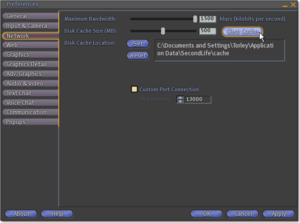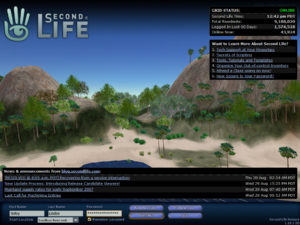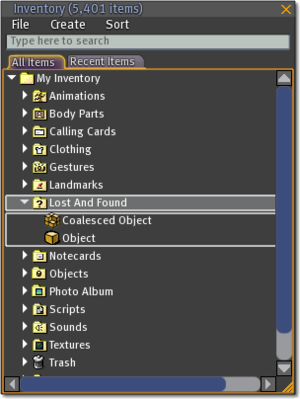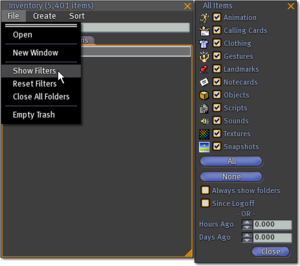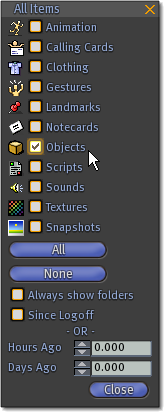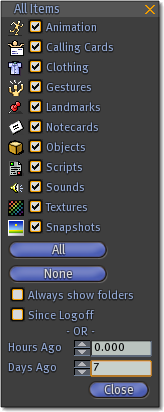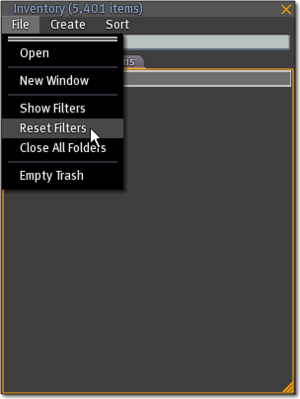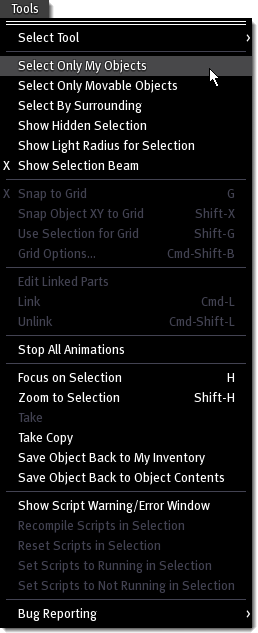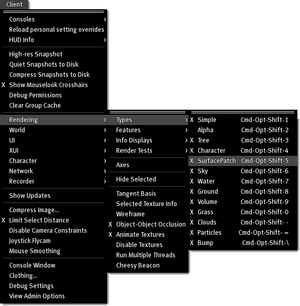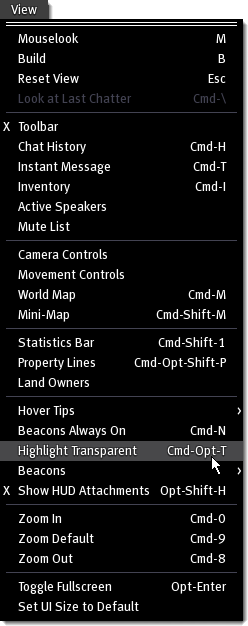Inventory loss
See also:
This page contains a complete list of steps a resident and follow to recover any inventory that is missing and is recoverable. These steps are used by different inventory letters, each letter specific to the type of loss that occurred.
COMMON SOLUTIONS
Clearing Second Life's cache
Second Life uses hard drive space on your computer to store data, including a list of items in your inventory. If this cache becomes corrupted, items in your inventory may erroneously appear to be missing. In many cases, your items are not lost and will reappear after you clear Second Life's cache:
- Go to Edit > Preferences on the menu bar
- Click the Network tab
- Click the Clear Cache button
- Exit Second Life
- Log back into Second Life
- Wait in place for 5 minutes; Second Life needs to reload much of your previously cached information.
Region issues
The Region you are in may be experiencing technical difficulties, especially in high traffic areas. This behavior can prevent you from rezzing items from your inventory. If you are unable to escape to another Region, exit Second Life and log back into a different Region:
- Go to Edit > Preferences on the menu bar
- Click the General tab
- Turn on the option Show Start Location on Login Screen
- Exit Second Life
- Launch Second Life, but don't connect yet
- Enter Sandbox Newcomb, or another known Region name, into Start Location
- Click Connect
Try to find a Region with a low Traffic score and relatively few objects- such Regions generally experience less strain, and are less likely to exhibit symptoms like inventory loss.
SEARCH TECHNIQUES
Did the objects vanish after being returned?
The Coalesce feature may cause confusion by making it appear that objects have vanished instead of being returned to your inventory. When a group of objects gets returned, they are merged into a single, coalesced object. This object is then placed back into your inventory, in your Lost and Found folder.
For example, imagine you have a living room. Inside the living room there is a television, coffee table, sofa, rug and a remote control. Then, by accident, everything is returned! To locate the returned objects, you search through your inventory, but after searching, the only object you can locate is the remote control. Where did everything else go? The television, coffee table, sofa and rug have been merged with the remote control. Simply drag the remote control from your inventory onto the ground everything else that was returned with the remote control should appear.
Trivia: Icons are used to represent different types of items in your inventory. The icons used for objects and coalesced objects are similar, but different. The object has an icon that looks like a cube, the coalesced object has an icon that looks like a stack of cubes.
Use the steps below to locate objects that have been recently coalesced and returned to your inventory:
- Click the Inventory button
- In the Inventory window, go to Sort > By Date
- Locate the Lost and Found folder
- From top to bottom, work through the list of objects, dragging each object onto the ground until you locate the missing objects
[AUTHOR/IMAGE/CAPTION] Needs new and improved demonstration
Inventory Filters
The Filters panel in your Inventory window contains a list of different inventory types. To learn how to use the Filters panel, follow the steps below:
- Click the Inventory button
- Inside the Inventory window, choose File > Reset Filters
- Choose File > Show Filters
Here, we make adjustments so that we only view Objects in the search results:
- Click the None button to turn off all filtering type options
- Go back and turn on the Objects option
To view objects placed into your inventory within the last 7 days:
- Enter "7" into Days Ago
- Press the Enter key
To find your own filtering style, experiment with the options in the Filters panel. If you ever need to reset all options back to their defaults, simply go to File > Reset Filters.
OTHER TIPS & TRICKS
Use the Mini-Map to locate your objects
The Mini-Map can be a useful tool to help you locate objects inworld. To activate the Mini-Map, click the Mini-Map button at the bottom of the screen.
Can I resize the Mini-Map?
- Yes. Click and drag the mouse at the bottom-right corner to the Mini-Map window.
Can I zoom in on the Mini-Map?
- Yes. Right-click the Mini-Map window and choose Zoom Close. The Mini-Map's default is Zoom Medium. You can also use your mousewheel to control zoom on the Mini-Map.
What do the different colors mean?
- Cyan (light blue) represents your objects
- Pink represents objects deeded to a group of which you are a member
- Gray represents objects that belong to other Residents
Select Only My Objects
The Tools menu has a useful option that allows you to select only objects that are owned by you. This can help locate all your objects in the immediate area; they may be hidden by other Resident's objects.
- Go to Tools > Select Only My Objects on the menu bar
- Go to Tools > Select Tool > Edit on the menu bar
Now that the Edit tool is activated, click-and-drag your mouse to make a selection. The only objects to highlight will be yours, possibly revealing the object you were unable to see before.
Locate items lost underground
Objects may be lost underground as the result of an editing mistake or by changes in the terrain. The following steps provide instructions to help locate objects that may be stuck underground.
- First, hide the ground in Second Life: Activate the Client menu on the menu bar by pressing Ctrl+Alt+D. Then, choose Client > Rendering > Type > Surface Patch.
- Press Esc a couple times to deactivate any open windows and close the chat box
- Hold down the Alt key and press Page Up or Page Down. This allows you to rotate your camera, locating any of your objects that may be buried underground.
Invisible objects
It may be impossible to see some objects if they are invisible. The Highlight Transparent feature allows you to view invisible objects. Transparent objects will turn translucent red once this feature has been enabled.
- Go to View > Highlight Transparent on the menu bar
Beacons
Often, object you are looking for may contain a script. Beacons make it easy to locate any objects that contain a script.
- Go to View > Beacons > Scripted Objects on the menu bar
If the beacons don't appear to be working, make sure the Render Beacons option is enabled. This draws crosshairs over any beacons, making them easier to locate.
- Go to View > Beacons > Render Beacons on the menu bar
There is an option in Preferences that increases the line width used for beacons, making them easier to view. This is especially useful when Second Life is displayed at a high resolution.
- Go to Edit > Preferences on the menu bar
- Click the Adv. Graphics tab
- Enter "2", or another value, into Debug Beacon Line Width
- Click OK
Request a replacement
Many vendors understand that items may be lost by accident or as the result of an unfortunate circumstance. If recovery efforts fail, contact the vendor and request a replacement.
COMMON CAUSES OF INVENTORY LOSS
Inventory offers declined while in Busy Mode
Any inventory offers to your avatar while in Busy Mode are automatically declined. To locate items that have been declined, search your Trash folder; all declined inventory offers go to your Trash.
Is a friend allowed to modify your objects?
Friends who have modify rights to your objects can move them around, possibly to a location where someone may return or delete them. Modify rights also allow friends to take copies of objects that are transferable. When a friend with modify rights tries to copy an object that can't be copied but is transferable, they take ownership of the object.
Land owned by a Resident
A Resident who owns a parcel of land can return or delete any objects placed onto their land. Second Life sends notifications when objects are returned, but not for objects that have been deleted.
Land deeded to a group
Any group member with the ability to return objects can return or delete objects placed on group-owned land. Typically, Owners and Officers of a group have this ability.
Second Life sends notifications when objects are returned, but not for objects that have been deleted.
Any object that is shared or deeded to group can be manipulated or possibly taken by group members with the "Manipulate (move, copy, modify) group-owned objects" ability. Typically, Owners and Officers of a group have this ability.
Shared or deeded objects may have been taken or moved to another location and later returned or deleted.
Private Regions
Any objects located on a Private Region (a Region owned by a Resident) can be returned by the Region owner or an Estate Manager. Second Life sends notifications when objects are returned.
Autoreturn
Any objects not owned by the land owner, or not set to the group to which the land is deeded, will be returned after a set time limit if autoreturn is enabled.
Decrease in available prims
The number of primitives a land parcel supports is calculated by the total square meters of land owned by a resident or group in a Region. If the total square meters of land decreases, the parcel may no longer support the primitives on the land, resulting in the return of any excess objects.
- Example: John Doe owns two parcels of land in a region. Each parcel of land is 512 square meters. The total square meters of land owned by John Doe is 1024 square meters. Normally, 512 square meters of land supports 117 primitives and 1024 square meters of land 234 primitives. John Doe can place all 234 primitives on one of his parcels. However, if John Doe deeds one of these parcels to a group or sells it to another resident, the existing parcel will only support 117 primitives. Any extra primitives will be returned.
Inventory never received
A malfunction or region issues may cause a scripted vendor to fail to deliver purchased items. Unfortunately, there is nothing Second Life Support can do to help recover items that were never received.
Contact the Resident that sold the items, and explain that you never received your purchase. If you are unsure who to contact, you may look at your transaction history:
Loss of objects as the result of a Region crash
Recently rezzed objects that are missing after a Region crash have likely been lost. A Region rolls back to a previously saved state when it recovers from a crash. Sadly, anything lost as the result of a Region crash cannot be recovered.
Inventory accidentally placed into an object
Items may have been accidentally dragged from your Inventory window and placed into an object.
Items like notecards and sounds cannot be rezzed inworld. If you drag them from the Inventory window onto an inworld object, they will be placed into that object. An object can be placed into an inworld object if the CTRL key is pressed while dragging an object from the Inventory window onto the inworld object.
To see the contents of an inworld object, and possibly locate any inventory accidentally placed into it, right click the object and choose Edit. Then, in the Edit window, click the Contents tab.
Items accidentally given to another avatar
It is possible your items may have been given to another Resident by mistake. There are two ways this can happen: If the items are dragged from your Inventory window onto an avatar inworld, or if the items are dragged from your Inventory window onto someone else's profile window.
PERCEIVED INVENTORY LOSS
Sometimes it may appear that you have lost part of your inventory because outside forces can prevent Second Life from displaying your inventory properly. Remember: common solutions and search techniques can often solve a case of perceived inventory loss!
Connectivity problems
An unstable Internet connection can lead to apparent inventory loss in Second Life. High packet loss may cause your inventory to be unable to retrieve a complete list of items from Second Life’s servers. Wireless and satellite connections are unsupported for this reason, and other types of connectivity may yield similar results.
Temporary inventory loss
There may be a temporary problem with Second Life or your connection to the Internet. If the list of items in your Inventory usually loads without incident, temporary inventory loss may go away within 24 hours.
How many items are in your inventory?
Keeping your inventory tidy is always a good idea. If your inventory has more than 10,000 items, the list of items in your Inventory may fail to load in a timely fashion. To make sure your inventory loads quickly and properly, go through the list of items in your inventory and remove any items no longer needed.
